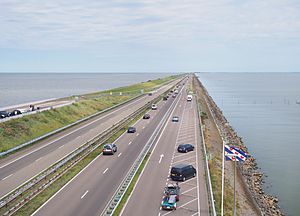Causeway facts for kids
A causeway is like a special road or railway built on a raised path, usually across a wide area of water or wet land. Think of it as a long, strong bridge made mostly of earth or stone, connecting two places over water. Causeways are different from viaducts, which are roads or railways supported by many arches, often leading to a bridge.
Contents
What is a Causeway?
Causeways are built to help people travel over water or marshy areas that would otherwise be hard to cross. They are often found connecting islands to the mainland or crossing large lakes and bays. Some causeways are so low that they get covered by water during high tide, making them temporarily unusable.
How Did the Word "Causeway" Come About?
The word "causeway" comes from an older word, "causey." This word has roots in Latin, from the word calx, which means "heel." This is because early causeways were built by packing down layers of earth, often by people or even animals like sheep trampling on them. This made the ground very firm and strong.
Imagine building a path by stomping on the dirt over and over again. That's how the idea of a "causey" or "causeway" started – as a firmly packed, trodden path. Today, machines do this work much faster and more efficiently.
How Are Causeways Built?
Modern causeways are built using strong engineering methods. Often, they are constructed inside a "cofferdam." This is like building a temporary wall in the water using two parallel rows of steel or concrete walls. These walls are anchored together, creating a dry space in between where the causeway can be built.
Sometimes, a causeway also acts as a levee or dyke. This means it helps keep two bodies of water separate, especially if they have different water levels or if one is salt water and the other is fresh water. The road on top of the causeway makes the structure even stronger and helps prevent erosion. It also provides easy access for maintenance and public use.
Famous Causeways Around the World
Many important causeways exist globally, helping people and goods move easily.
- The Johor-Singapore Causeway connects Singapore and Malaysia. It carries both roads and railways, making it a vital link for trade and travel.
- The King Fahd Causeway is an impressive 25-kilometer (about 15.5 miles) long structure that links Bahrain and Saudi Arabia.
- In the Netherlands, the Afsluitdijk is a famous dyke that also serves as a causeway. It's part of a huge project to reclaim land from the sea.
- Louisiana in the United States is home to the Lake Pontchartrain Causeway. This is one of the longest bridges in the world, stretching almost 38 kilometers (about 23.6 miles) across Lake Pontchartrain.
- The Churchill Barriers in Orkney, Scotland, are a notable set of four causeways. They were built during World War II to protect a naval harbor.
- The Sweet Track in England is one of the oldest engineered roads ever found. It dates back to around 3800 BC!
- In Florida, many causeways connect barrier islands to the mainland. These often include low bridges and sometimes a higher bridge in the middle for boats to pass under.
- The Estrada do Istmo in Macau was originally a causeway connecting two islands. Over time, land was reclaimed around it, and the area is now known as Cotai, famous for its casinos.
More Causeways to Explore
- Canso Causeway, Nova Scotia, Canada
- Hindenburgdamm, Germany
- Gaoji Causeway, Xiamen, China
- Lucin Cutoff railroad causeway across the Great Salt Lake in Utah, USA
- MacArthur Causeway, Florida, United States
- Mahim Causeway, Mumbai, India
- Colaba Causeway, Mumbai, India
- Swarkestone causeway, Derby, England, United Kingdom
- Causeway across Haraldssund, Faroe Islands
- Causeway across Hvannasund, Faroe Islands
- Ijora Causeway, Lagos, Nigeria
- Giant's Causeway, Northern Ireland, United Kingdom (This one is a natural rock formation, not man-made!)
- Lake Cuitzeo Causeway, Michoacán, Mexico
- Robert Moses Causeway, Long Island, New York, United States
Things to Consider About Causeways
Causeways can sometimes affect the natural flow of water currents. This can lead to problems like beach erosion or changes in how sand and sediment are deposited. For example, the Hindenburgdamm in Germany has faced issues with erosion.
During hurricane season, causeways can become very dangerous. Strong winds, heavy rains, and large waves from storms can make them unsafe to cross. Because of this, authorities often make it a top priority to help people living on islands evacuate safely before a big storm hits. This also helps prevent traffic jams on the causeways themselves.
Images for kids
-
The Julia Tuttle Causeway, connecting Miami and Miami Beach
-
An aerial view of the Lucin Cutoff trestle before it was removed. The causeway built in the 1950s is on the right.
-
The causeway leading to Antelope Island in the Great Salt Lake, Utah
-
The Sorell Causeway in Tasmania, Australia
-
The Lake Pontchartrain Causeway bridge in New Orleans
-
A causeway across Colwyn Bay Beach, Wales, United Kingdom
-
The King Fahd Causeway seen from a satellite
-
A causeway in St. George's, Bermuda
-
A causeway connecting Victor Harbor with Granite Island in Australia, completed in 1867
-
The Canso Causeway from Cape Breton Island
See also
 In Spanish: Pedraplén para niños
In Spanish: Pedraplén para niños













